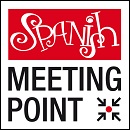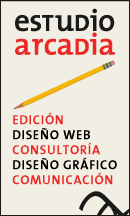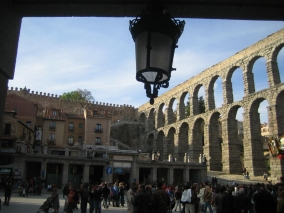Spanish schools and accommodation to study Spanish in Spain
Recent posts
Last schools
introduced
introduced
0 Accommodation

1 Spanish schools

Learning Spanish in Segovia. The tourist guide to study your Spanish course.
Think of Segovia and the Roman aqueduct appears infront of you. Take Spanish lessons surronded by Roman history in Spain.
General Information. 57,000 inhabitants. 87 kilometres to the northeast of Madrid. It is located in the Autonomous Community of Castile and León, in the foothills of the Sierra de Guadarrama and between the rivers Eresma and Clamores. Segovia has grown out of a mixture of Celtic, Roman, and Visigothic cultures and you will find signs of all three in the city today. Its economy is based mainly on the services and tourism sectors, which have flourished in the last few years. The authentic and well conserved old quarter has been declared a World Heritage Site. The most important monument to be found here is the Roman Aqueduct, which has now become the symbol of the city. In Segovia there is a campus belonging to the University of Valladolid, which offers degree courses in computer engineering, law, advertising and education. There is also a private university called IE, which belongs to the prestigious business school, the Instituto de Empresa. This organization is recognised internationally for its MBA courses and can also be found in Madrid. Segovia is a very attractive place to study Spanish with many language schools offering a wide range of courses.
Surrounding Areas. La Granja (12 kilometres), where you can visit the Palacio Real de la Granja de San Ildefonso, one of the official residences of the Spanish royal family; Riofrío (12 kilometres), where you will find the Palacio Real de Riofrío, also belonging to the royal family; El Chorro de Navafría (33 kilometres), a waterfall that descends a series of rocky slopes; Pedraza (40 kilometres), a walled medieval village, which boasts one of the most well-conserved 13th century castles in Spain; Prádena (50 kilometres), where you can see the cave of "los Enebralejos"; Coca (54 kilometres), with its 15th century Mudejar-Gothic castle and its old quarter which has been awarded Historic-Artistic Grouping status; Cuéllar (60 kilometres), whose old quarter was also given Historic-Artistic Grouping status in1994; Sepúlveda (60 kilometres), another town with a great historical heritage and which refers to itself as the world capital of roast lamb. It too has Historic-Artistic Grouping status and its municipal area contains the nature reserve Las Hoces del Río Duratón; Ávila (85 kilometres), a walled city and World Heritage Site; Madrid (92 kilometres).
World Heritage Site. In 1985 the old city of Segovia and its Aqueduct were declared a UNESCO World Heritage Site.
Main Sights. The Roman Aqueduct, built with some 25,000 granite blocks and located in the Plaza del Azoguejo, is 818 metres long and has over 170 arches. The Alcázar de Segovia, a royal palace built at the top of a rocky outcrop and a favourite residence of the kings and queens of Castile. St.Mary's Cathedral (Catedral de Santa María), the last Gothic building to be built in Spain. The city walls are also worthy of mention. Segovia has a great cultural heritage and this includes an important group of convents and Romanesque churches. The monuments are a major attraction for the many students who decide to study Spanish in Segovia.
Culture. The most important events in Segovia are: the Jazz Festival (at the end of November); Folk Segovia (end of June) and the Titirimundi International Puppet Festival (May). Some of the museums that should be highlighted are: the Esteban Vicente Contemporary Art Museum, where you can see the collection of artworks donated by the only Spaniard who belonged to the first generation of artists of the New York School of American Abstract Expressionism; the Segovia Museum and the Museum of Witchcraft (Museo de Brujería). Theatre performances can be seen at the Juan Bravo Theatre, which was built in 1917.
Shopping. Just like in olden times, the shops are located around the Plaza Mayor and in Calle Real, which form an authentic and natural shopping centre. Shopping areas can also be found in the following streets: Avenida Fernández, Calle José Zorrilla, Avenida de la Constitución and Estación de Tren. Segovia also has a shopping mall called Luz Castilla.
Gastronomy. To try the traditional Spanish snacks, known as pinchos and tapas, you should head for the Plaza Mayor and surrounding streets, where you will find bars that combine quality with reasonable prices. The typical dishes are: suckling pig (cochinillo), lamb, garlic and bread soup (sopa castellana) and beans from La Granja. Well-known restaurants, such as El Mesón de Cándido, can be found in the old quarter itself, between the Aqueduct and the Cathedral.
Sports. The most important sports team in the city is Caja Segovia. They play fútbol-sala or indoor 5-a-side soccer in the LNFS, which is the top league in Spain. Other popular sports that you can play or learn in Segovia are: cycling, adventure sports and golf.
Fiestas. The fiestas of St. John and St. Peter (San Juan y San Pedro) at the end of June are very special in Segovia and have been celebrated since the 15th century. One of Segovia's patron saints, San Frutos, is commemorated on 25th October with different festivities and cultural events. There is also a fiesta on the 25th September, held in honour of the city's other patron saint, the Virgen de la Fuencisla.
Transport. Segovia has a sightseeing bus which throughout the year. It is easy to get from Segovia to other Spanish cities by train or by using the various coach services.
Nightlife. Students who decide to study Spanish in Segovia will discover a very active nightlife. The liveliest areas in the city at night are: the old quarter, Paseo del Salón, San Millán and Santo Tomás-Mahonías. The pubs close at four in the morning and you will find many different types of late night vibe. Two well-known discotheques are Kyber and Yellow.
General Information. 57,000 inhabitants. 87 kilometres to the northeast of Madrid. It is located in the Autonomous Community of Castile and León, in the foothills of the Sierra de Guadarrama and between the rivers Eresma and Clamores. Segovia has grown out of a mixture of Celtic, Roman, and Visigothic cultures and you will find signs of all three in the city today. Its economy is based mainly on the services and tourism sectors, which have flourished in the last few years. The authentic and well conserved old quarter has been declared a World Heritage Site. The most important monument to be found here is the Roman Aqueduct, which has now become the symbol of the city. In Segovia there is a campus belonging to the University of Valladolid, which offers degree courses in computer engineering, law, advertising and education. There is also a private university called IE, which belongs to the prestigious business school, the Instituto de Empresa. This organization is recognised internationally for its MBA courses and can also be found in Madrid. Segovia is a very attractive place to study Spanish with many language schools offering a wide range of courses.
Surrounding Areas. La Granja (12 kilometres), where you can visit the Palacio Real de la Granja de San Ildefonso, one of the official residences of the Spanish royal family; Riofrío (12 kilometres), where you will find the Palacio Real de Riofrío, also belonging to the royal family; El Chorro de Navafría (33 kilometres), a waterfall that descends a series of rocky slopes; Pedraza (40 kilometres), a walled medieval village, which boasts one of the most well-conserved 13th century castles in Spain; Prádena (50 kilometres), where you can see the cave of "los Enebralejos"; Coca (54 kilometres), with its 15th century Mudejar-Gothic castle and its old quarter which has been awarded Historic-Artistic Grouping status; Cuéllar (60 kilometres), whose old quarter was also given Historic-Artistic Grouping status in1994; Sepúlveda (60 kilometres), another town with a great historical heritage and which refers to itself as the world capital of roast lamb. It too has Historic-Artistic Grouping status and its municipal area contains the nature reserve Las Hoces del Río Duratón; Ávila (85 kilometres), a walled city and World Heritage Site; Madrid (92 kilometres).
World Heritage Site. In 1985 the old city of Segovia and its Aqueduct were declared a UNESCO World Heritage Site.
Main Sights. The Roman Aqueduct, built with some 25,000 granite blocks and located in the Plaza del Azoguejo, is 818 metres long and has over 170 arches. The Alcázar de Segovia, a royal palace built at the top of a rocky outcrop and a favourite residence of the kings and queens of Castile. St.Mary's Cathedral (Catedral de Santa María), the last Gothic building to be built in Spain. The city walls are also worthy of mention. Segovia has a great cultural heritage and this includes an important group of convents and Romanesque churches. The monuments are a major attraction for the many students who decide to study Spanish in Segovia.
Culture. The most important events in Segovia are: the Jazz Festival (at the end of November); Folk Segovia (end of June) and the Titirimundi International Puppet Festival (May). Some of the museums that should be highlighted are: the Esteban Vicente Contemporary Art Museum, where you can see the collection of artworks donated by the only Spaniard who belonged to the first generation of artists of the New York School of American Abstract Expressionism; the Segovia Museum and the Museum of Witchcraft (Museo de Brujería). Theatre performances can be seen at the Juan Bravo Theatre, which was built in 1917.
Shopping. Just like in olden times, the shops are located around the Plaza Mayor and in Calle Real, which form an authentic and natural shopping centre. Shopping areas can also be found in the following streets: Avenida Fernández, Calle José Zorrilla, Avenida de la Constitución and Estación de Tren. Segovia also has a shopping mall called Luz Castilla.
Gastronomy. To try the traditional Spanish snacks, known as pinchos and tapas, you should head for the Plaza Mayor and surrounding streets, where you will find bars that combine quality with reasonable prices. The typical dishes are: suckling pig (cochinillo), lamb, garlic and bread soup (sopa castellana) and beans from La Granja. Well-known restaurants, such as El Mesón de Cándido, can be found in the old quarter itself, between the Aqueduct and the Cathedral.
Sports. The most important sports team in the city is Caja Segovia. They play fútbol-sala or indoor 5-a-side soccer in the LNFS, which is the top league in Spain. Other popular sports that you can play or learn in Segovia are: cycling, adventure sports and golf.
Fiestas. The fiestas of St. John and St. Peter (San Juan y San Pedro) at the end of June are very special in Segovia and have been celebrated since the 15th century. One of Segovia's patron saints, San Frutos, is commemorated on 25th October with different festivities and cultural events. There is also a fiesta on the 25th September, held in honour of the city's other patron saint, the Virgen de la Fuencisla.
Transport. Segovia has a sightseeing bus which throughout the year. It is easy to get from Segovia to other Spanish cities by train or by using the various coach services.
Nightlife. Students who decide to study Spanish in Segovia will discover a very active nightlife. The liveliest areas in the city at night are: the old quarter, Paseo del Salón, San Millán and Santo Tomás-Mahonías. The pubs close at four in the morning and you will find many different types of late night vibe. Two well-known discotheques are Kyber and Yellow.
© TEXT: SPANISH IN TOUR.
VIDEO: Patronato de Turismo de Segovia
VIDEO: Patronato de Turismo de Segovia

























